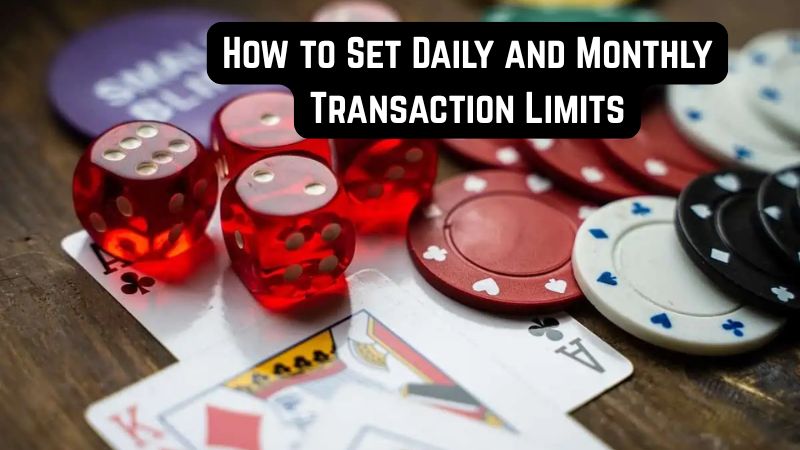In today’s digital age, managing your finances has become much easier, thanks to online banking and financial apps. However, with this convenience comes the need for extra security. One effective way to protect your financial transactions is by setting daily and monthly transaction limits. These limits ensure that you don’t spend more than you intend to and protect your accounts from unauthorized transactions. Let’s explore how to set daily and monthly transaction limits, step by step.
What are Daily and Monthly Transaction Limits?
Transaction limits are restrictions placed on your account to control how much money you can withdraw, spend, or transfer within a specific time frame. A daily transaction limit applies to the total amount of money you can move in one day, while a monthly limit applies to your transactions over the span of a month. These limits are particularly useful for preventing large-scale fraud and protecting your financial well-being.
Why Set Transaction Limits?
Setting transaction limits can give you peace of mind. It helps prevent overspending, unauthorized access, and fraud. Additionally, these limits allow you to have better control over your budgeting. If someone gains access to your account, they won’t be able to drain all your funds immediately, as long as the limits are in place. Limits also ensure that you’re not exceeding your own financial boundaries.
Benefits of Daily Transaction Limits
A daily limit can be especially helpful in managing your cash flow. It gives you the power to restrict how much you can spend or transfer each day. For example, if you want to control your spending habits, setting a daily limit on purchases can help you stick to your budget. It also ensures that you’re not caught off guard by unauthorized transactions, as the system will block any attempts that exceed the limit.
Benefits of Monthly Transaction Limits
Monthly limits are great for managing larger financial activities, like paying bills or making substantial purchases. With a monthly limit, you can prevent yourself from overspending over a longer period, providing a safeguard against impulse buys. It also protects your savings by ensuring you don’t make excessive withdrawals or transfers that could impact your overall financial health.
How to Set Daily Transaction Limits
Setting a daily transaction limit can usually be done directly through your bank’s online platform or mobile banking app. Follow these simple steps:
- Log into your Online Banking: Access your bank’s website or app and log into your account using your credentials.
- Go to Security Settings: Once logged in, navigate to the settings section of your account. Look for the “Security” or “Transaction Limits” section.
- Set the Limit: You’ll see options to set both daily and monthly limits. Enter the maximum amount of money you wish to allow for transactions in a single day. Some banks may let you set different limits for various types of transactions, such as withdrawals, transfers, or online payments.
- Confirm Changes: After setting your desired limits, confirm the changes. Some banks may require you to verify the changes via an OTP (One-Time Password) or email confirmation.
Once the daily limit is set, any transactions exceeding the specified amount will be blocked or flagged for further verification.
How to Set Monthly Transaction Limits
Setting a monthly transaction limit follows a similar process to setting daily limits. Here’s how to do it:
- Login to Your Bank Account: Just like setting daily limits, you’ll first need to log into your bank’s website or app.
- Access the Transaction Limit Section: Go to the section where you can manage your account settings, and locate the “Transaction Limits” or “Security” section.
- Choose the Monthly Limit Option: You’ll be prompted to set your monthly transaction limit. Choose an amount that you’re comfortable with, considering your regular monthly expenses and transfers.
- Save the Changes: Once you’ve entered your limit, save your changes. Again, verification may be required through email or a code sent to your phone.
With the monthly limit in place, you’ll have more control over larger financial moves. This also protects you from making accidental transactions that go beyond your budget.
Tips for Setting Effective Limits
When setting transaction limits, it’s important to find a balance. Setting the limit too low might cause unnecessary inconvenience, while setting it too high might not provide the security you’re looking for. Here are a few tips:
- Review Your Spending Habits: Before setting a limit, take a look at your average daily and monthly spending. Consider your usual expenses, such as bills, groceries, and entertainment, and set limits accordingly.
- Include a Buffer: It’s always a good idea to set your limits a little higher than your average spending to accommodate emergencies or unexpected purchases.
- Account for Different Transactions: You might want different limits for different types of transactions. For example, you may want to set a lower limit for online purchases but a higher limit for in-person purchases.
- Change Limits as Needed: Your financial situation might change over time. Don’t hesitate to adjust your limits as your income or spending habits evolve.
Can You Modify Your Transaction Limits?
Yes, you can modify your transaction limits at any time. Most banks allow you to increase or decrease your daily or monthly limits. This can be done through the bank’s app or website, and changes are typically processed quickly. However, keep in mind that frequent changes may raise concerns for the bank, and some banks may require additional verification before making significant adjustments.
How Transaction Limits Protect You from Fraud
One of the most significant advantages of setting transaction limits is the added layer of security it provides against fraud. If someone gains access to your account, they won’t be able to withdraw large sums of money or make big purchases without hitting the daily or monthly limits. If any suspicious activity occurs, you’ll be immediately alerted, and the unauthorized transaction will be blocked.
Should You Set Limits for Every Transaction?
While setting limits for every transaction can provide maximum security, it might not be necessary for everyone. If you’re comfortable with your bank’s security features, such as two-factor authentication or fraud alerts, you may not need to set limits for every type of transaction. However, if you prefer extra caution, setting limits on high-risk transactions, like large transfers or online shopping, can be a smart move.
Conclusion
Setting daily and monthly transaction limits is an excellent way to take control of your finances and protect yourself from fraud. By setting reasonable limits, you can prevent unauthorized transactions and avoid overspending. Most banks make it easy to set these limits through their online banking platforms or apps, so there’s no reason not to take advantage of this security feature. Keep in mind that it’s essential to review your limits periodically to ensure they still align with your financial goals.



